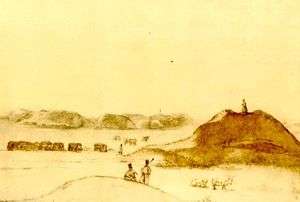Chumak
|
Taras Shevchenko, Chumaks among burial mounds, 1846 | |
| Occupation | |
|---|---|
| Names | Salt traders, salt dealers |
Occupation type | vocation |
Activity sectors | trading, salt industry |
| Description | |
| Competencies | social skills |
Chumak (Ukrainian: чумак) is a historic occupation on the territory of the modern Ukraine as merchants or traders, primarily known for the trade in salt.
Chumaks grew as a merchant class facilitating trade of salt from the areas of Halychyna as well as the coastal areas of Black and Azov Seas, in addition to other items.
They prospered until the end of the 19th century, when competition from railroads made longer trade routes unprofitable.[1] The process of transportation was conducted by a wagons that were pulled by two oxen paired with yoke. Oxen were often of Bessarabian breed.
Chumaks were the most popular during the times of the Cossack Hetmanate (17th century) trading between the Moscow state, the Polish-Lithuanian Commonwealth, the Crimean Khanate, and Moldavia. Further modernization marginalized traditional economic activity, and relegated Chumak traders to areas in western Ukraine with the lowest levels of service.
Influence on the Ukrainian culture

The style of living of chumaks set a great mark in the Ukrainian folklore, language, and the culture overall.
In Ukrainian language Milky Way is called the Chumaks' Way. There is a Ukrainian surname Chumak.
Chumak traders also were featured heavily in Ukrainian folklore and fables. Their trade is mentioned in the literal as well as artistic works of Taras Shevchenko, the Crimean-Armenian Ivan Aivazovsky, the song of Taras Petrynenko Ukraina.
References
- ↑ Chumak (decline) at the Chumatstvo.info
External links
- Chumak's roads by A.Basargina, a senior scientist at the Belgorod State Museum of Folk Culture (YouTube)
